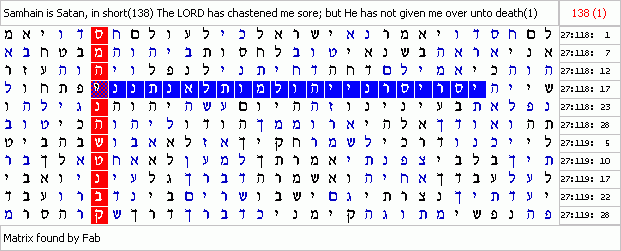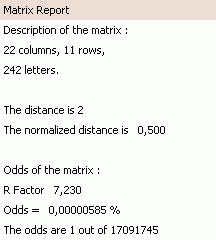
Code by Fab (12/Nov/2008)
Samhain is Satan; in short.



After
finding the "Halloween is demonic"
code, I tried to search for a code about the identity of "Samhain"
(the false pagan god who gave his name to "the Celtic festival
that marks the beginning of winter", cf "Encyclopedia Mythica"
by M.F. Lindemans), and according to the "Occult Dictionary"
by Ishlti, there is an obvious connection between Samhain and Halloween:
"...The festival of remembrance for the dead, held on the eve of
Nov. 1st. It is the last of the three harvests. This festival also marks
the transition of rulership of the "Wheel of the Year"
from that of the goddess to that of the God. One of the eight sabbats.
This day is also known as Halloween..."
And the Encyclopedia Britannica states: “(The festival of) Samhain
was an important precursor to Halloween.”
To the ancient Celts, Samhain was the "lord of the dead",
and according to the Bible, Satan is the master/lord of death:
http://www.thercg.org/articles/totuh.html
Who Is the “Lord of the Dead”?
Now what about Samhain, the so-called lord of the dead? God tells us
about “…him who had the power of death, that is, the devil”
(Heb. 2:14). Satan the devil was lord, or master, of the dead!
The ancient Celts, who thought they were serving God, were deceived
into worshipping the god of this world, who is the father of lies and
religious deception. We will see that this same being stands behind
the modern-day festival of Samhain (Gal. 4:8; Rev. 12:9; II Cor.
4:4; John 8:44).
So I decided to search for the expression "Samhain is Satan". In the Hebrew Bible, Satan appears for the first time in the Book of 1 Chronicles 21:1:
"And Satan stood up against Israel, and provoked David to number Israel."
But the way it is spelled (without the article "hey" before) also means "adversary", and in all the other contexts where it is used in the Tanakh, refers to human adversaries only (cf 1 Kings 5:4, 11:14, 11:23, 11:25), the only time it refers to the Devil is in 1 Chro 21:1. All the other times Satan's name is mentioned (14 mentions in Job, and 2 in Zechariah 3:2) in the Tanakh, his name is spelled with the article "hey" ("the") before it ("the Satan" then). So I used the long and most often used spelling instead, and found only one occurrence of the expression "Samhain is Satan" with a firly short skip of + 138, it showed up in entirely in the Book of Psalms (where many other codes about Jesus, the NT, and Satan have been found, btw), and could be exteded to "Samhain is (the) Satan, in short", with an interesting connection to the surface text, since one of the letter in the main term lands on:
Psalm 118:17: "The LORD has chastened me sore; but He has not given me over unto death."
-I also noticed the shortest skip of "Samhain" (-1) in the Tanakh, appeared in Ezekiel 23:15:
"Girded with girdles upon their loins, with pendant turbans upon their heads, all of them captains to look upon, the likeness of the sons of Babylon, even of Chaldea, the land of their nativity."
And could be extended to "A spirit (spelled in reverse). Samhain"
-I also found some interesting new terms, in the near vicinity of the "Halloween is demonic" code. One states "day (of) the enemy (enemy is spelled in reverse)", according to the "Occult Dictionary" by Ishlti:
"...The
festival of remembrance for the dead, held on the eve of Nov. 1st. It
is the last of the three harvests. This festival also marks the transition
of rulership of the "Wheel of the Year" from that of the goddess
to that of the God. One of the eight sabbats. This day is also known
as Halloween..."
Another "they cheated them", and close to it, and spelled
in reverse, "Rome", also interesting since:
http://www.thercg.org/articles/totuh.html
Next Came the Catholic Church
During the first, second and third centuries, all professing Christians—both
true and false—suffered periodic persecution from the Roman Empire,
which viewed any form of Christianity as an illegal religion. But in
A.D. 313, that changed for some. The Roman Catholic Church—which
began with the sorcerer Simon Magus, who is mentioned in chapter eight
of the Book of Acts—found favor in the eyes of Emperor Constantine.
(To learn more, read our book The History of the True Church –
Where Is It Today?.) For the first time in the history of the Roman
Empire, the pope, now backed by Roman civil authority, had free reign
to determine what was “Christian”—and what was not.
Throughout the early years of the Catholic Church, worshippers observed
special anniversaries for martyrs who had been executed for their beliefs.
Soon there weren’t enough days in the calendar year to dedicate
a specific day for each individual martyr, so the Catholics observed
one feast day for all martyrs.
“In the fourth century, neighboring dioceses began to interchange feasts, to transfer relics, to divide them, and to join in a common feast; as is shown by the invitation of St. Basil of Caesarea (A.D. 397) to the bishops of the province of Pontus. Frequently groups of martyrs suffered on the same day, which naturally led to a joint commemoration…[T]he number of martyrs became so great that a separate day could not be assigned to each. But the Church, feeling that every martyr should be venerated, appointed a common day for all” (Catholic Encyclopedia).
So the Catholic Church, with the backing of the government, decided to “white-wash” a Roman holiday. Tired of admonishing the Romans for engaging in drunken revelries as an excuse to honor the dead (and desiring more converts), Pope Boniface IV, in A.D. 609, declared Feralia to be Christian. Instead of honoring all of the dead, they were now just to honor dead “saints.” Instead of drunken revelries, it would be a day of prayer and meditation. Instead of calling it Feralia, he changed it to All Saints’ Day. And he moved the date of its observance from February 21 to May 13. “Boniface IV, [on] 13 May, 609, or 610, consecrated the Pantheon in Rome to the Blessed Virgin and all the martyrs, ordering an anniversary” (Ibid.).
Then, Pope Gregory III, who reigned 731-741, “consecrated a chapel in the Basilica of St. Peter to all the saints and fixed the anniversary for 1 November” (Catholic Encyclopedia). He broadened “the festival [of All Saints’ Day] to include all saints as well as all martyrs” (Encyclopedia Britannica).
Meanwhile,
the Celts were still observing the festival of Samhain in one form or
another. The Catholic Church took note and Pope Gregory IV (827-844)
attempted to replace it by moving All Saints’ Day from May 13 to
November 1—the same day as Samhain—officially extending the
festival to the entire church. All Saints’ Day became known
as All Hallows Day, while October 31 became All Hallows Eve and, eventually,
Halloween.